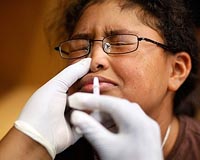| . |  |
. |
Brussels (AFP) Oct 26, 2009 Almost one in three people infected with the virus that causes AIDS do not know they have the disease, increasing the risk of infection, the European Commission warned Monday. In a document on combatting AIDS more than a quarter century after it surfaced, the EU's executive arm said now was not the time for Europe to drop its guard, noting that the figure was up to double in some neighbour nations. And while efficient treatments exist to slow the evolution of the human immunodeficiency virus (HIV), no vaccine or cure has been found. "We need to continue the political momentum in the fight against HIV/AIDS," EU Health Commissioner Androulla Vassiliou said in a statement. "We need to encourage people to take responsibility for themselves and their partners by talking about and practicing safe sex and going for HIV testing," she said. According to commission figures, the number of people living with HIV or AIDS in the 27 EU countries and its neighbours rose from 1.5 million in 2001 to 2.2 million in 2007, around 730,000 of whom live in the bloc. Some 50,000 new cases of HIV were diagnosed in the EU and its neighbours in 2007. The percentage of adults, ranging in age from 15 to 49, infected with HIV vary widely, from less than 0.1 percent in some countries to more than 1.0 percent in others. France, Italy, Spain and Portugal have relatively high infection rates -- ranging from 0.4 percent to 0.5 percent -- but the number roughly triples in Estonia, which has a rate of 1.3 percent. In Russia, around 1.1 percent of the population is HIV positive, while the figure climbs to 1.6 percent in Ukraine. Share This Article With Planet Earth
Related Links Epidemics on Earth - Bird Flu, HIV/AIDS, Ebola
 More than half of Chinese don't want swine flu shot: poll
More than half of Chinese don't want swine flu shot: pollBeijing (AFP) Oct 26, 2009 More than half of all Chinese do not plan to be vaccinated against swine flu because they are unsure about the safety of the shot, according to a survey by state media published Monday. The poll by the China Daily and popular web portal sohu.com said more than 54 percent of the 2,000 respondents said they did not want the A(H1N1) vaccine -- a huge turnaround from two months ago, when 76 ... read more |
|
| The content herein, unless otherwise known to be public domain, are Copyright 1995-2009 - SpaceDaily. AFP and UPI Wire Stories are copyright Agence France-Presse and United Press International. ESA Portal Reports are copyright European Space Agency. All NASA sourced material is public domain. Additional copyrights may apply in whole or part to other bona fide parties. Advertising does not imply endorsement,agreement or approval of any opinions, statements or information provided by SpaceDaily on any Web page published or hosted by SpaceDaily. Privacy Statement |